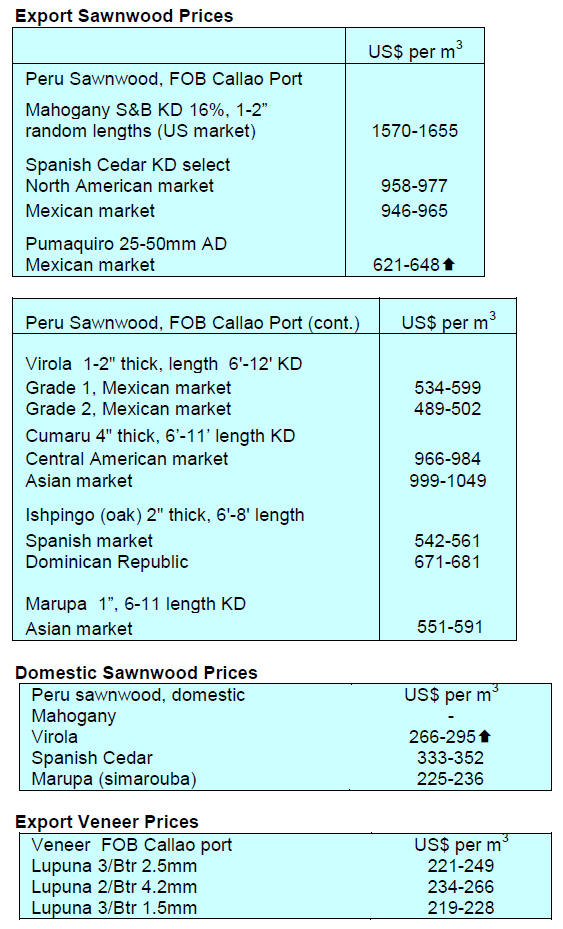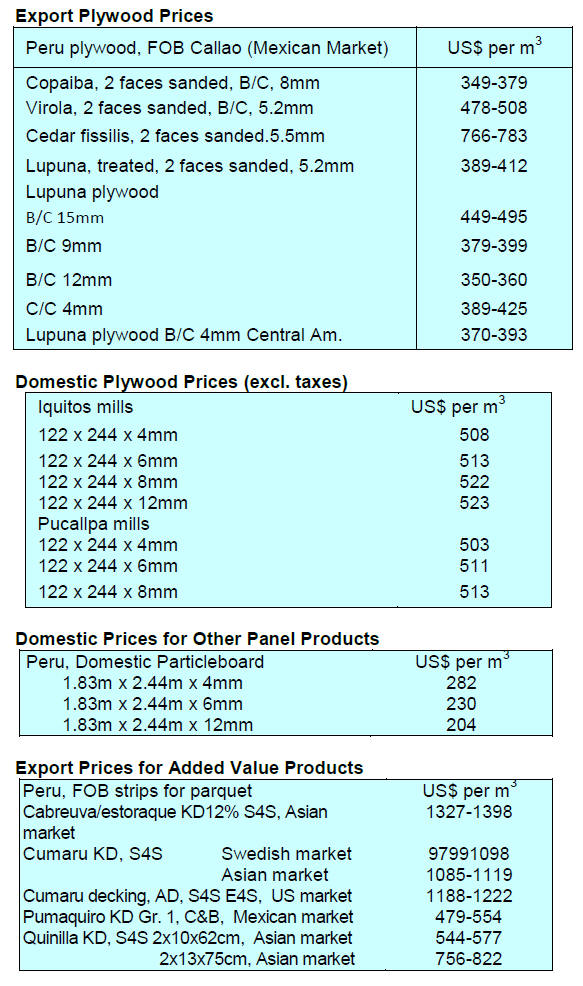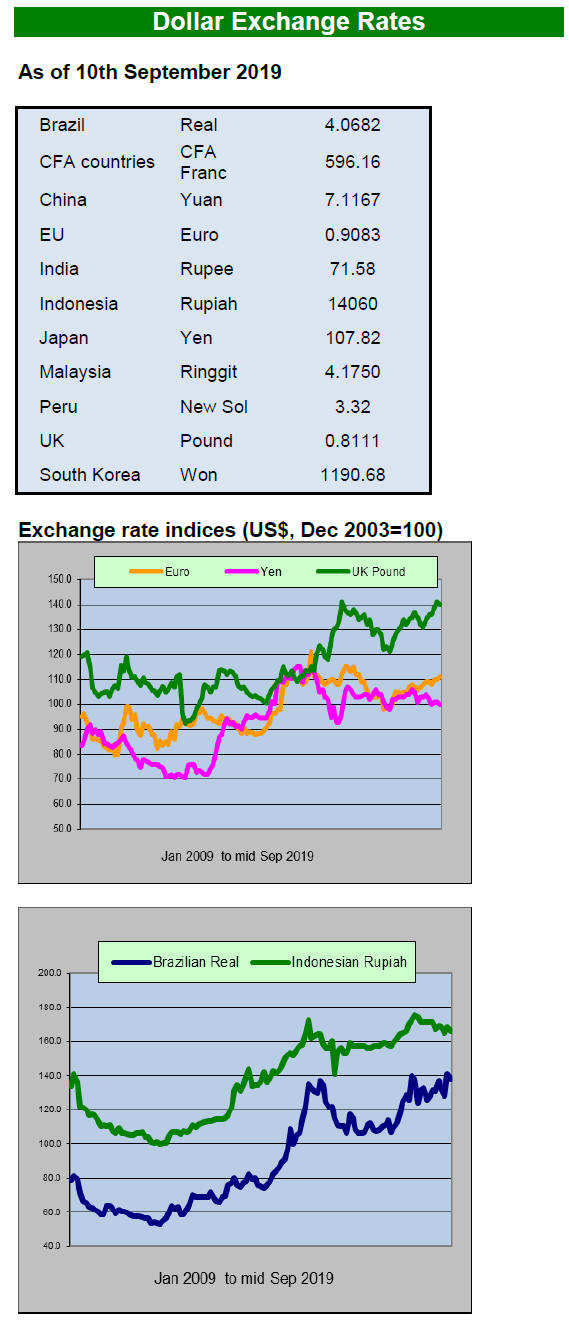3.
MALAYSIA
Formaldehyde limits for domestic
panel sales
Limits on formaldehyde emissions are mandatory in many consumer countries
and the Malaysian panel products industry responds accordingly when
exporting.
However, presently in Malaysia there are no regulations on formaldehyde
emission levels for the domestic market. All wood panel products whether
manufactured locally for imported for Malaysian consumers are not subject to
inspection for formaldehyde emission levels.
To address this, the Malaysian Panel Products Manufacturers Association
(MPMA) requested the Ministry of Primary Industries (MPI) to regulate
formaldehyde emission for all panel products for the
domestic market whether they be locally manufactured or imported.
Since 2016, the Malaysian market has been flooded with imported plywood
which was suspected to have high formaldehyde content.
An awareness event was recently conducted by the Malaysian Timber Industry
Board (MTIB) among domestic plywood mills, workers, agents/importers,
intermediate users and the public. An investigation of formaldehyde emission
from Malaysian made plywood for the domestic market has been completed and
studies on MDF and particleboard are on-going.
Based on the results of an earlier study and after considering the
capability of the local wood-based panel sector a regulation for a
formaldehyde emission limit of ≤ 1.5 mg/L (F**/E1 class) on imported and
locally produced wood-based panels products was recommended. The majority of
Malaysian manufacturers can reach this standard.
Yayasan Sabah strikes a deal to spur downstream processing
The timber group Priceworth International has signed a memorandum of
understanding on log supply which will see Yayasan Sabah’s Innoprise Corp.
become a shareholder with a stake of 30% in Priceworth.
Innoprise Corp. is the investment arm of Yayasan Sabah. Yayasan Sabah (Sabah
Foundation) is a state sanctioned organisation that promotes education and
economic opportunities for the benefit of the people of Sabah. Yayasan Sabah
has the state’s largest timber concession and forest plantations.
The local media report that Priceworth and Yayasan Sabah will work on a
framework for a partnership to encourage more downstream processing in
Sabah’s timber industry at the same time complementing each other in
sustainable forest management.
Harvesting limits and low rainfall hit earnings of Sarawak companies
Sarawak timber companies WTK Holdings (WTK) and Jaya Tiasa Holdings (Jaya
Tiasa) have reported first six month2019 earnings and both point to the poor
performance of their timber and plantation sectors.
Jaya Tiasa reported a 24% drop in revenues in the first six months while WTK
reported a 17% decline in revenues for its first six months of 2019. In
commenting on the performance WTK blamed lower log output due to the dry
weather which hampered river transportation.
Plywood prices
Plywood traders based in Sarawak reported the following July export prices.
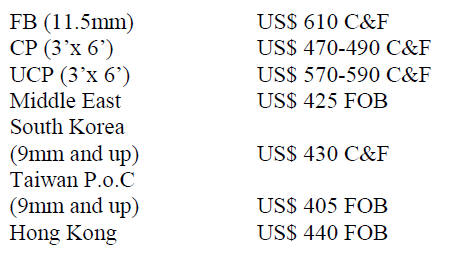
4.
INDONESIA
Looking for wider markets in Australia
When the new Indonesian Timber Exchange is up and running the Association of
Indonesian Forest Concessionaires (APHI) expects this year’s sales to
Australia to increase by as much as 10%.
Purwadi, APHI Chairman, said that at present only merbau from Papua and West
Papua is marketed in Australia but hopes other timbers such as matoa,
mersawa, nyatoh and resak can secure market share in Australia.
John Halkett, General Manager of the Australian Timber Importer Federation,
said that hardwood from Indonesia is used mainly for home construction in
Australia and that to market other non-structural timbers a strong marketing
campaign must be launched.
Site of new capital announced
Indonesia’s President, Joko Widodo, has announced that planning is underway
to move the capital to Borneo. Jakarta overcrowded and prone to flooding as
much of the city is below sea level and because it continues to sink.
Physical infrastructure worksfor the new capital will likely begin in 2024.
The new capital would be located in East Kalimantan Province near Samarinda
and the port city of Balikpapan.
Estimates put the cost at around US$33 billion of which around 20% would
come from government, the rest coming from public-private partnerships and
private investment. Homes for around 1.5 million civil servants will be
required.
CIFOR applauds improvements in forest governance
The Director General of the Center for International Forestry Research
(CIFOR), Robert Nasi, has applauded the advances made in forest governance
in Indonesia.
In a presentation at a forest policy discussion hosted by the Ministry of
Environment and Forestry he specifically mentioned achievements over the
past five years in establishing the Peat Restoration Agency and efforts to
reduce the occurrence of fires on peatlands.
Also mentioned was the social forestry programme which is distributing
forest land user rights over more than 12 million hectares of forest to
local communities.
Other successes mentioned were the conclusion of the VPA and issuance of
FLEGT licenses to verify Indonesia's legal wood products exported to the EU
and the moratorium on granting of new concessions for oil palm plantations.
Nasi stated that there was still a lot of work to be done especially in
terms of mapping, monitoring, transparency, and implementation in the field.
See:
https://indopos.co.id/read/2019/09/04/191911/perbaikan-signifikan-tata-kelola-hutan-di-indonesia-diapresiasi-cifor/
Furniture exhibited at Cologne show
Indonesian companies took part in the 2019 Spoga + Gafa International
exhibition held in Cologne as this was an opportunity to promote Indonesian
furniture products, not only for the German market, but also markets in
neighbouring countries.
Apart from Germans, visitors were from England, Spain, Italy, Norway, Sweden
and Latin America. Indonesian furniture entrepreneurs who participated in
the exhibition said that Indonesia's biggest competitor in international
furniture markets is now Vietnam.
Business mission to Europe and US
Indonesia's Chamber of Commerce and Industry (KADIN) will arrange a business
mission to 14 European nations and the US to boost investment and trade ties
and follow up on the ongoing trade agreement negotiations. The business
mission will focus on the vision "Making Indonesia 4.0" which aims to make
Indonesia one of the world's 10 largest economies in 2030.
In a press conference Kadin Deputy Chief for International Relations, Shinta
Widjaja, said the mission will emphasise multisectoral development
encompassing agriculture, chemical industry, packing industry, food and
beverage industry, logistics, shipbuilding, maritime port, furniture, and
the handicraft industry.
The mission to Europe began 13 September and covers visits to Turkey,
Bulgaria, Greece, Serbia, Romania, the Netherlands, Slovakia, Poland,
Switzerland, Germany, Italy, the United Kingdom, Belgium, and France.
The mission to the US will conclude on 9 October and cover involves visits
to New York, Washington, Atlanta, and Los Angeles.
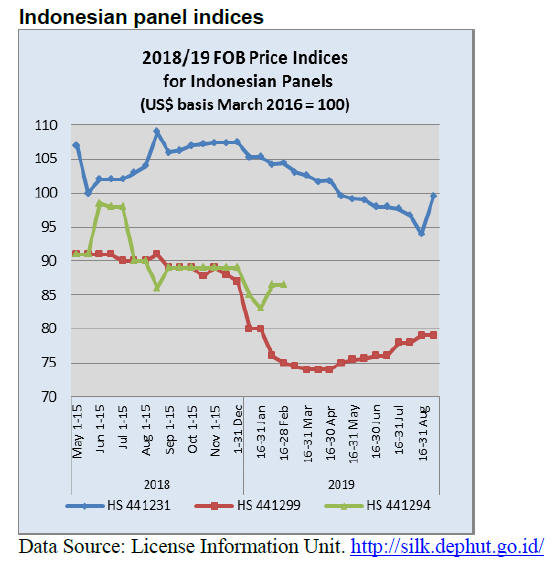
5.
MYANMAR
Plan to garner support from ethnic groups
to protect the forest
The Myanmar Times has reported on comments from U Ye Myint Swe, Deputy
Minister of Natural Resources and Environmental Conservation and Dawn Del
Rio, Deputy Resident Representative of the United Nations Development
Programme (UNDP), to the effect that the government needs the cooperation of
armed ethnic groups across the country if it is to effectively address the
destruction of forests.
It was announced that a plan to fight deforestation is being jointly drafted
by the ministry and the UNDP.
See:
https://www.mmtimes.com/news/officials-want-enlist-ethnic-armed-groups-deforestation-fight.html
Support from Karen needed to protect natural resources
The forests in the Tanintharyi Region have been subject to massive
harvesting for charcoal production, a threat that first came to light 10
years ago.
The Tanintharyi Region borders the Andaman Sea and much of the coastal
mangrove has been over harvested for charcoal production. This threat
emerged in about 2005 and worried the mainly ethnic Karen villagers who had
seen the destruction caused by charcoal burners.
In related news, the Forest Department and the Karen National Union have met
to initiate cooperation for the protection of the natural resources and
lives of the Karen people.
Community forest project back on track
A 30-year forestry master plan launched by the Forest Department in 2001 set
a target of establishing community forests on almost 1 million ha, or three
percent of total forest land in Myanmar, by 2030.
As of November last year, community forests had been established on only
221,169ha, or about 24 percent of the target according to data compiled by
Voices for Mekong Forests, a European Union-funded project being implemented
by a consortium of national and international NGOs.
Government figures show that community forest approvals have increased
significantly since 2014, however. Over the past four years, 162,480 ha of
community forest has been created, compared to less than 60,000 ha in the
preceding two decades.
U Kyaw Zaw, Deputy Permanent Secretary in the Ministry of Natural Resources
and Environmental Conservation, said harvesting in community forests would
provide cash incomes for rural communities.
Volatility in exchange rate addressed by Central Bank
According to U Soe Min, Vice Governor of the Central Bank of Myanmar (CBM),
the bank has acted to stabilise the Kyat exchange rate and may consider
intervening in the foreign exchange markets. This was in response to the
recent exchange rate volatility the result of comments from officials to the
effect that local banks have “runaway non-performing loans”.
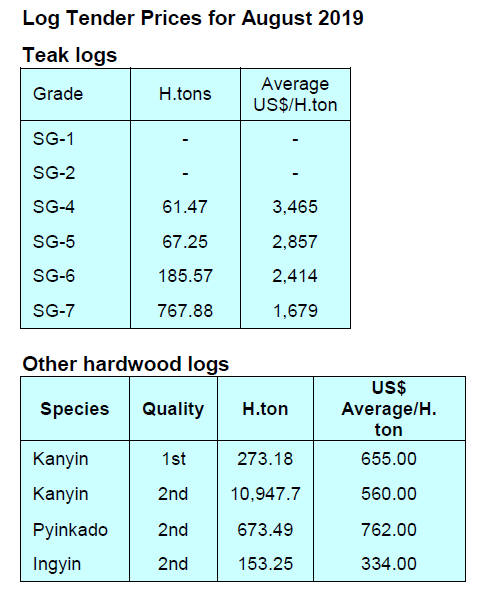
6. INDIA
Residential real estate sector has
potential to almost double from the current 1.5 million units in key cities
CREDAI, in association with its knowledge partner CBRE (one of the largest
real estate and investment firms) released a report “India 2030 – Exploring
the Future” at its 19th Annual International Convention, NATCON 2019 in
Israel. The report encapsulates the potential of Indian economy by 2030 and
its implications on the growth of Indian Real Estate sector.
India is projected to have a US$9 trillion economic opportunity by 2030,
wherein the per capita income could touch US$5,625 for a population of about
1.5 billion and required annual spending on infrastructure could rise to
7-8% of GDP.
Emergence of India’s digital, sharing and consumer economy, evolution of
workplace strategy, technology will also bode well for the industry. The
demand for residential and office stock will continue to grow at the back of
policy reforms on Affordable Housing and close-integration of start-ups and
conglomerates to offer tech-enabled services.
By 2030 the residential real estate sector has the potential to almost
double from the current stock of 1.5 million units in key cities says the
report. The millennial population is expected to account for 77% of the
overall working population in India by 2030. The housing needs of this group
is unique as they look for convenience, service and a stressfree experience
when purchasing.
Consumer demand will remain concentrated in the affordable segment and will
gradually shift towards the mid-range segment but affordable housing will
remain the dominant segment in the coming years.
See:
https://credai.org/press-releases/credai---cbre-report-exploring-the-future-identifies-key-trends-paving-the-way-for-growth-of-real-estate-in-2030
Unintended consequences – CITES rosewood regulation impacts
livelihood of Indian farmers
Writing in the Times of India under the headline “The commercial extinction
of Indian rosewood from global markets - Abundant yet redundant“ Varsha
Singh explains the impact on Indian farmers of the CITES listing of
rosewood.
Despite the decision by CITES to allow cross border transport of finished
musical instruments with rosewood components without the need for CITES
permits as well as trade in finished rosewood products such as handicrafts
weighing less than 10 kilograms per shipment, the tight regulation of
rosewood is impacting Indian farmers.
Dalbergia sissoo or rosewood is available in abundance in India and is
widely preferred in Indian households as the best choice for home
furnishings.
The decision to list rosewood by CITES has affected farmers in India who
rely on sissoo (shisham) trees to supplement their income. Singh writes “Dalbergia
sissoo is a species for agroforestry and millions of farmers plant this in
their fields as an investment for future needs such as children’s education,
medical emergencies etc. and as an insurance against bad years“.
Citing a Botanical Survey of India which shows Dalbergia sissoo does not
fall into any threatened category and is available in abundance both in the
wild and cultivated populations the Ministry of Environment attempted to
delist Indian rosewood but CITES was not convinced.
Read more at:
http://timesofindia.indiatimes.com/articleshow/70941048.cms?utm_source=contentofinterest&utm_medium=text&utm_campaign=cppst
Indian furniture makers show interest in Swedish softwood
In a press release Swedish Wood, which represents the Swedish sawmill
industry and is part of the Swedish Forest Industries Federation, reports
that its experience at the recent ‘India Wood‘ was that Indian industry is
showing strong interest in Swedish pine, particularly for furniture and
joinery.
There was strong interest in the Swedish softwoods, particularly pine, from
visitors who mainly comprised representatives of Indian furniture and
joinery companies, wood importers and, to a lesser extent, interior
designers, architects and furniture designers.
Charlotte Dedye Apelgren, Director of Interior and Design at Swedish Wood
writes “The signals we received from the Indian furniture market at the
trade show is that the younger generation are showing an interest in
softwood furniture that is relatively light, feels modern and is easy to
transport when moving house, for example.”
Swedish exports of sawn wood products to India are currently quite modest
but they are growing rapidly. Last year Sweden exported 27,000 cubic metres
of sawn softwood worth around SEK 50 million. Sweden is the fifth largest
country for softwood exports to India and has seen the greatest increase in
exports in recent years. The Swedish sawmill industry sees India as a
priority market for the future, and exports to India from Sweden are
expected to continue growing.
See:
https://www.swedishwood.com/about_us/news/2018/3/india-has-the-potential-to-become-an-important-market-for-swedish-pine-in-the-future2/
Plantation teak imports
The rupee/dollar exchange rate has become more volatile in recent weeks. In
early September the dollar was at over 72 rupees but a slight strengthening
of the dollar lifted the rate back to 71 to the dollar in mid-month.
Analysts write that the government has signalled it is closely watching
exchange rates and the performance of the economy. Many analysts expect
further stimulus to boost growth.
C&F rates for Indian ports from various other sources continue within the
same range as given earlier.
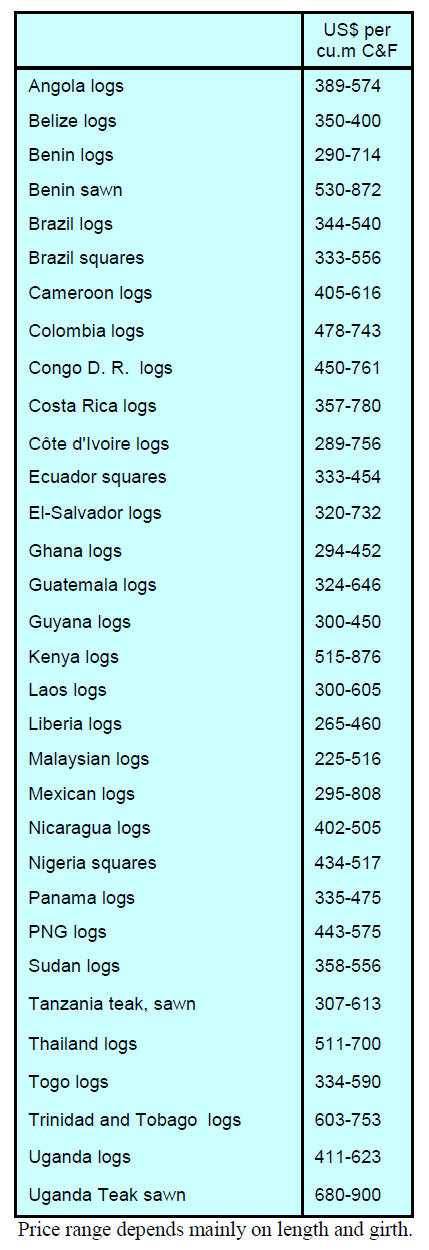
Locally sawn hardwood prices
Demand for domestically sawn imported hardwoods has been maintained and
supplies are stable. Prices remained unchanged over the past two weeks.
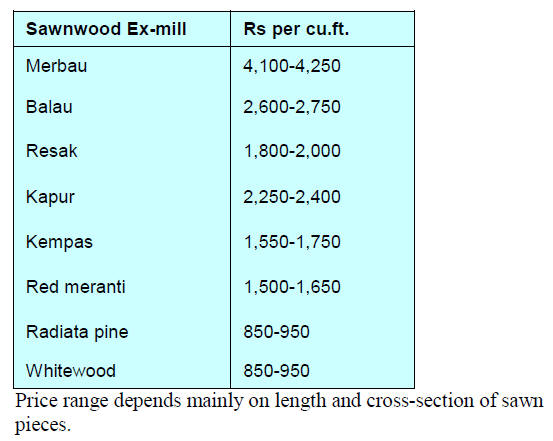
Myanmar teak prices
Demand for Myanmar teak has slowed mirroring the strengthening of the rupee
which pushed up import costs. Looking ahead, importers are hoping a change
in GST rates will allow them to maintain sales prices.
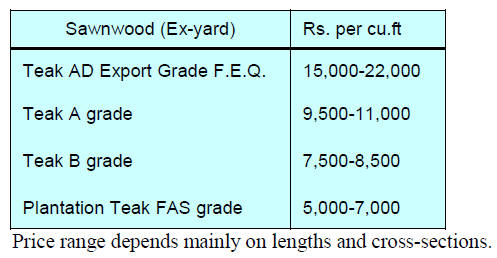
Sawn hardwood prices
Current prices are unchanged.
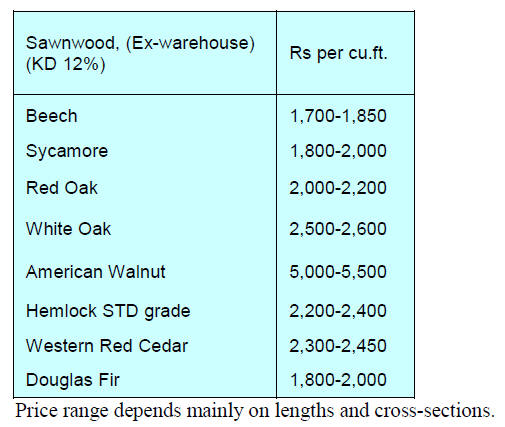
Plywood
End-users continue to purchase at the recently increased base price.
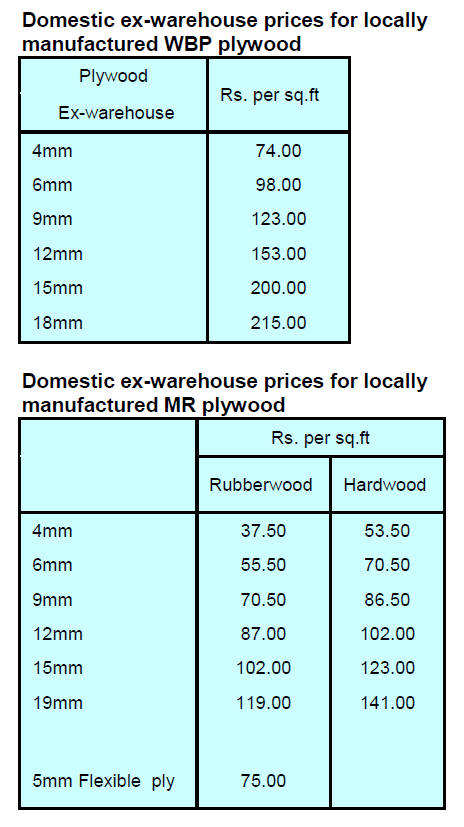
7.
VIETNAM
Production and exports first 7 months of
2019
In early September the Ministry of Agriculture and Rural Development
arranged a conference on forestry development and wood processing,
production and exports for the first 7 months of 2019. During the conference
the Ministry presented its plans for the final months of this year. It was
reported that Vietnam’s exports of forest and wood products in the first 7
months reached US$6.047 billion up by 17.9% compared to the same period in
2018.
Vietnamese wood products are exported to over 128 markets. The top 5 export
markets are the US, EU, China, Japan and S. Korea which accounted exports of
US$5.3 billion or around 88%, of total exports.
In Vietnam, as of July, there were about 5,424 enterprises of which 621 were
foreign investments.
In the conference, the VFA commented on future opportunities and challenges,
especially how Vietnamese exporters could take advantage of the US-China
trade conflict to capture a large share of the US market lost by Chinese
competitors.
This said, the VFA could identify opportunities for Vietnamese firms to
enhance their productivity, market capacity and economic value as added
value products are demanded in the US market.
The other advantage for the country as a result of the US/China conflict has
been increasing foreign investment flows from China into Vietnam aiming to
take advantages of competitive labour costs, the favourable business
environment and supportive infrastructure. Furthermore, the Vietnam/EU VPA
FLEGT and new forest laws that came into forces in June 2019 has facilitated
wood processing and exports to the EU as well as other global markets.
Regarding challenges the VFA highlighted concerns on possible negative
environmental, social and economic impact of incoming investment in the
forestry sector. There are also serious concerns on possible commercial
fraud and fake origin documentation for wood products which would undermine
the credibility of reputable companies that export.
The other worrying issue is the increasing trade deficit between Vietnam and
the US,. Discussions are underway to find a solution to address this
imbalance.
See:
http://tongcuclamnghiep.gov.vn/LamNghiep/Index/hoi-nghi-danh-gia-tinh-hinh-che-bien-xuat-khau-go-va-lam-san-cac-thang-dau-nam-2019-4060
Fostering forest plantation for exports in Vietnam
Quangtri, in the Central Vietnam, has suffered serious forest loss and is a
poor province but efforts by the government in cooperation with WWF are
having a positive impact and the forest cover has risen from 47% in 2010 to
almost 50% this year. The support for Quangtri was initiated in 2017 through
a joint programme for sustainable forest development by WWF, the Vietnam
Forest Administration (VFA) and the Quangtri Department of Agricultural and
Rural Development.
At the same time as the forest area was being expanded policies were adopted
to support local enterprises in establishing wood processing capacity. There
is an estimated 22,000 ha of FSC-certified plantation forests in 31 clusters
in 51 districts of Quangtri.
See:
https://nongnghiep.vn/day-manh-trong-rung-gan-voi-xuat-khau-post248941.html
8. BRAZIL
Drop in June furniture production but
half year figures remain positive
The Furniture Industry Association of Rio Grande do Sul (Movergs) recently
presented the results of its survey of the furniture sector in Rio Grande do
Sul. The survey covers the retail trade, industry and job creation.
Overall, furniture sales in June declined as the number of furniture pieces
sold fell 9.7% compared to May and retail income also fell (-10%). The
recent decline reverses an uninterrupted period of expansion that began in
February this year. However, due to the good sales results up to May, the
growth in sales in the first half of 2019 expanded 3.2% year on year.
In terms of production, June saw an 11% decline compared to May. Despite
this, in the first six months of 2019 the overall decline in production was
just 1.2% compared to the first half of 2018 yet revenues earned by the
furniture industry grew 7.5% in the first months of 2019.
Furniture production in Rio Grande do Sul has shown ups and downs. In the
first quarter there were two months of consecutive declines (February and
March). The months of April and May showed growth but that was reversed in
June, the worst month of the year so far.
Because of the slowdown, job creation in the sector fell in June and
compared to the first half of 2018 there was a fall in jobs this first half.
New report – recovery of 12 million ha. of native vegetation
possible by 2030
The Brazilian Platform on Biodiversity and Ecosystem Services (BPBES),
supported by the Research Programme on Biodiversity Characterisation,
Conservation and Sustainable Use (-FAPESP-BIOTA) and the International
Institute for Sustainability (ISS), has released the document “Landscape and
Ecosystem Restoration”, which states that it is possible to recover 12
million hectares of native vegetation of the country by 2030.
Brazil has lost about 71 million hectares of native vegetation in the last
30 years as a result of deforestation and forest fires among other factors
according to MapBiomas. This damage can be repaired through enabling the
recovery of 12 million hectares of native vegetation across the country by
2030 as set out in the National Ecological Restoration Plan.
Through this it would be possible to sequester 1.4 megatons (Mt) of carbon
dioxide (CO2) from the atmosphere, interconnect natural fragments in the
landscape and further increase biodiversity conservation without impairing
agriculture output.
Brazil has the opportunity to develop a unique native vegetation recovery
programme for forested areas of the Atlantic Forest and the Amazon
rainforest.
This is because the country can count on a great diversity of species in
restoration projects.
See:
https://www.ipbes.net/news/launch-summary-policy-makers-1st-brazilian-assessment-biodiversity-ecosystem-services
China is main competitors in the US moulding market
The global market for mouldings is important for Brazilian exporters. In
2018, Brazil exported about US$214 million in mouldings mainly to the US
which accounted for over 90% of the total volume of timber mouldings
exported. The balance was exported to over 20 countries.
Brazilian wood mouldings are mainly made from pine and the main producers
are located in Paraná and Santa Catarina. Together these states produce
almost the entire volume of mouldings made in the country. Paraná leads in
exports, accounting for about 75% of the total volume.
According to the Brazilian Association of Mechanically-Processed Timber
Industry (ABIMCI), “the moulding market is stagnant due to constraints on
civil construction work in the US and the aggressive strategy of Chinese
producers. China is Brazil’s biggest competitor in the US market, the
world's main consumer.
Furniture imports and exports
The Brazilian Furniture Industry Association (Abimóvel) has released the
main furniture market indicators for June and July 2019. In June 2019,
Brazilian furniture exports totaled US$50.8 million, down 10.7% over the
previous month, while imports grew 3.5% in June, reaching US$15.5 million.
In July, Brazilian furniture exports totalled US$54 million, an increase of
6.3% compared to June, while imports increased 6.7% in July, reaching
US$16.5 million. In June 2019, the share of imported furniture in Brazil in
apparent consumption was 3.1%, while the share of exported furniture in
production was 7.3%.
On the other hand, Brazilian furniture sector exports totalled US$353.6
million in the year to June 2019 representing a 4.1% increase compared to
the same period of 2018. Of this total, furniture exports to the United
States which accounts for a third of exports increased of 12.5% year on
year.
The states of Santa Catarina (41.3%), Rio Grande do Sul (28.9%) and Paraná
(14.8%) together accounted for over 80% of Brazilian furniture exports
between January and July 2019.
In terms of imports, of the main suppliers French and Mexican shippers saw
significant growth compared to a year earlier.
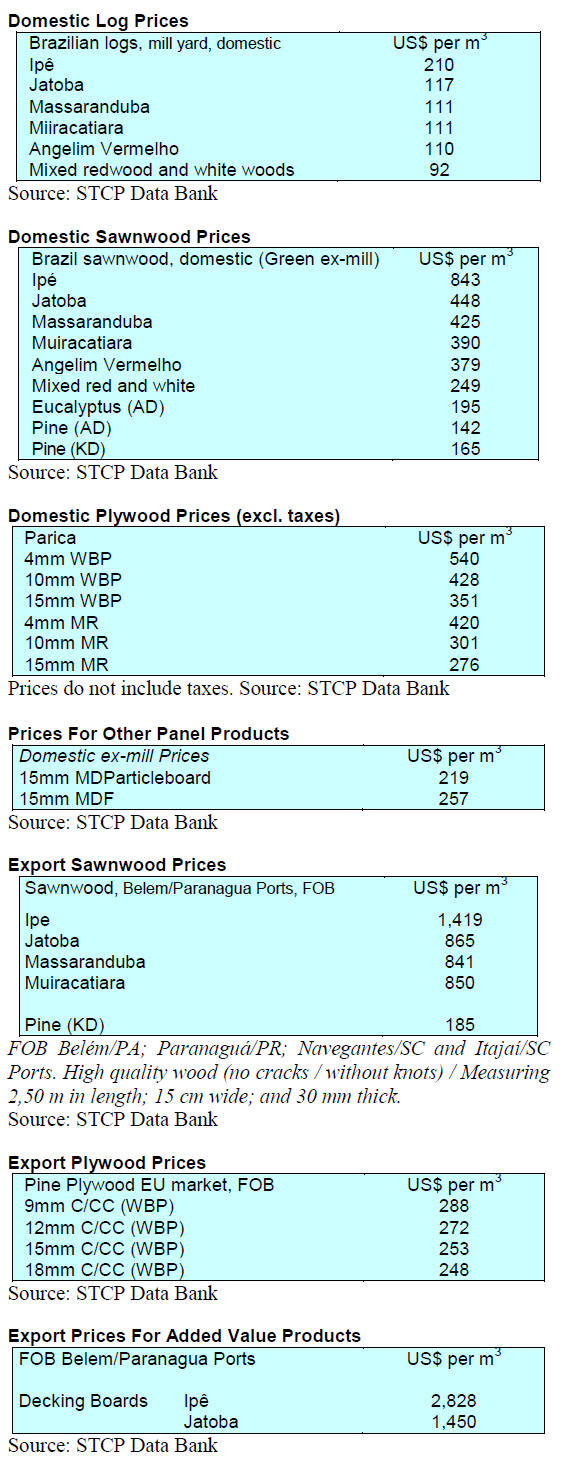
9. PERU
National training on forest
product identification
Stakeholders involved in monitoring, control and promotion of wood products
have been participating in a national training programme on a recently
updated Explanatory Guide for Timber Identification which was published at
the end of last year.
This training was an initiative of the National Forest and Wildlife Service
(SERFOR) with technical support from the USAID FOREST programme and the
United States Forest Service.
The objective of this training programme was to raise awareness of the
criteria and methodology used in preparation of the guide and the additional
features. The training aimed to facilitate the identification of the 85
forest products contained in the new list.
The training programme began at the end of July and culminated at the
beginning of September. Workshops were held in Lima, Ucayali and Madre de
Dios and involved about 150 technicians and specialists in the forestry
sector.
Exchange visit to Colorado
In early September a delegation of Peruvian officials visited the US to meet
with US Forest Service staff to experience environmental management and
impact assessment in projects in Colorado national forests.
The Peruvian delegation comprised officials from the National Environmental
Certification Service (SENACE), the Environmental Assessment and Control
Agency (OEFA), the Ministry of Environment and the Ministry of Energy and
Mines. A representative of the Confederation of Amazonian Nationalities of
Peru (CONAP) and a student from the National University of the Peruvian
Amazon (UNAP) also participated.
During the visit the Peruvian delegation were shown various projects
implemented within national forests managed with the participation of the
USFS, Bureau of Land Management (BLM), Colorado Department of Natural
Resources, Colorado State Forest Service and the private sector.
The visit allowed Peruvian officials to understand that with proper zoning
and management it is possible to conserve the forest and wildlife while also
performing profitable and responsible extractive activities.
Forest fires extinguish in Ucayali
Four forest fires recorded during the first week of September in the
districts of Campo Verde, Yarinacocha, Raymondi and Alexander Von Humboldt
(Ucayali) were completely extinguished thanks to the work of the personnel
of the Volunteer Fire Department of Peru, local authorities and residents of
area. Personnel from the Office of Disaster Risk Management conducted damage
assessment and needs analysis.
SERFOR - Amazon countries must establish a pact to protect the
Amazon
The Executive Director of the National Forest and Wildlife Service (SERFOR),
Alberto Gonzales-Zúńiga Guzmán, has emphasised the willingness of the
governments of Peru and Colombia to integrate their respective policies for
sustainable use of the Amazon and said that this vision should be shared by
all Amazonian countries.
Gonzales-Zúńiga said that, although it is important that the G7 developed
countries announced their intention to present a plan for the reforestation
of the Amazon it is much more important that the Amazon countries themselves
establish a pact to ensure protection of the Amazon.
Gonzales-Zúńiga indicated that deforestation is a permanent problem in
Amazonian countries. In Peru, in 2017, 155,914 hectares of Amazon forest
were deforested. Almost 60% were concentrated in four Amazonian regions,
Ucayali, Madre de Dios, Huánuco and Loreto.
Shifting agriculture is one of the causes of deforestation in the humid
Amazonian forests that is why Gonzales-Zúńiga said that SERFOR will continue
with a campaign to raise awareness among farmers that they cannot burn
illegally.
